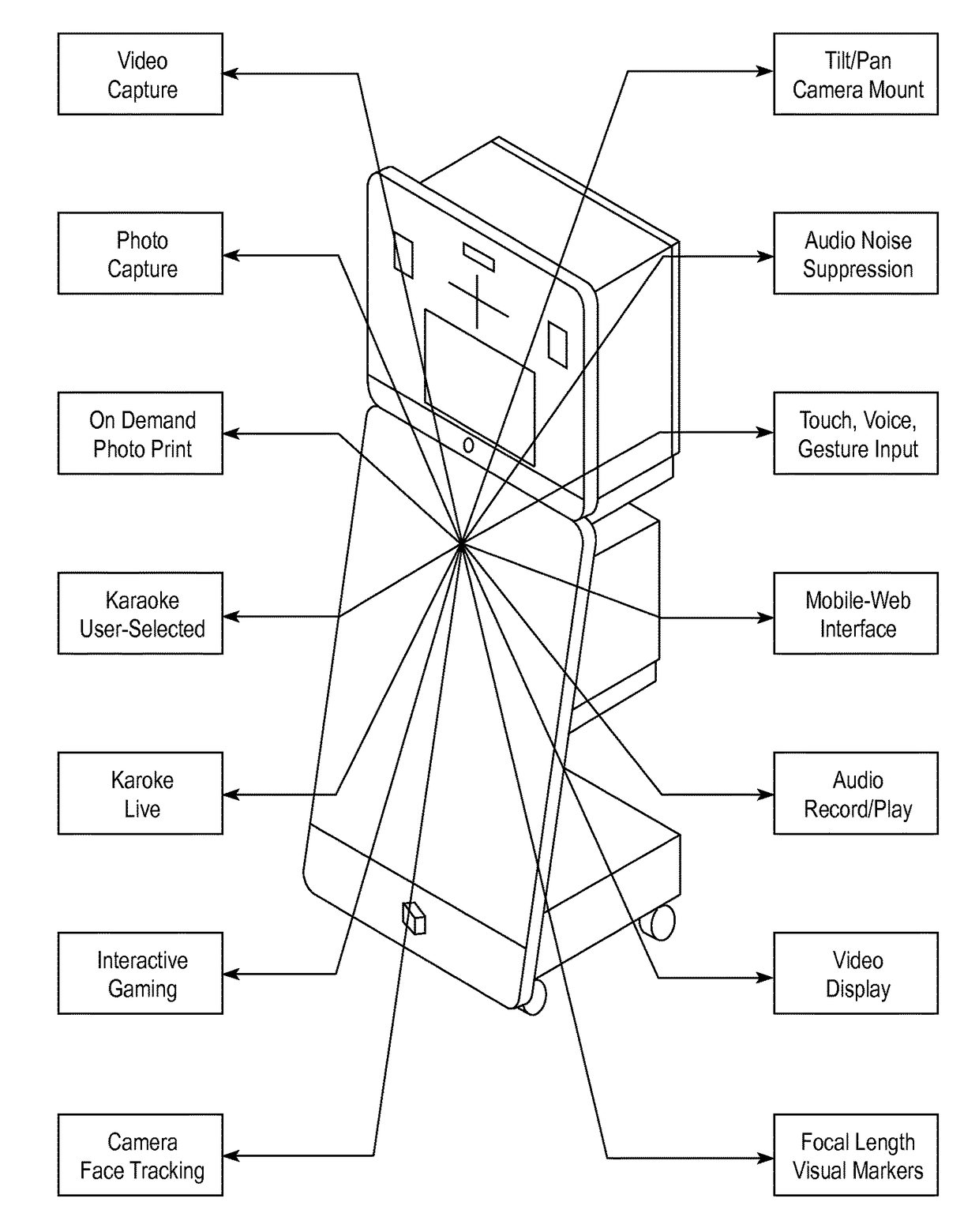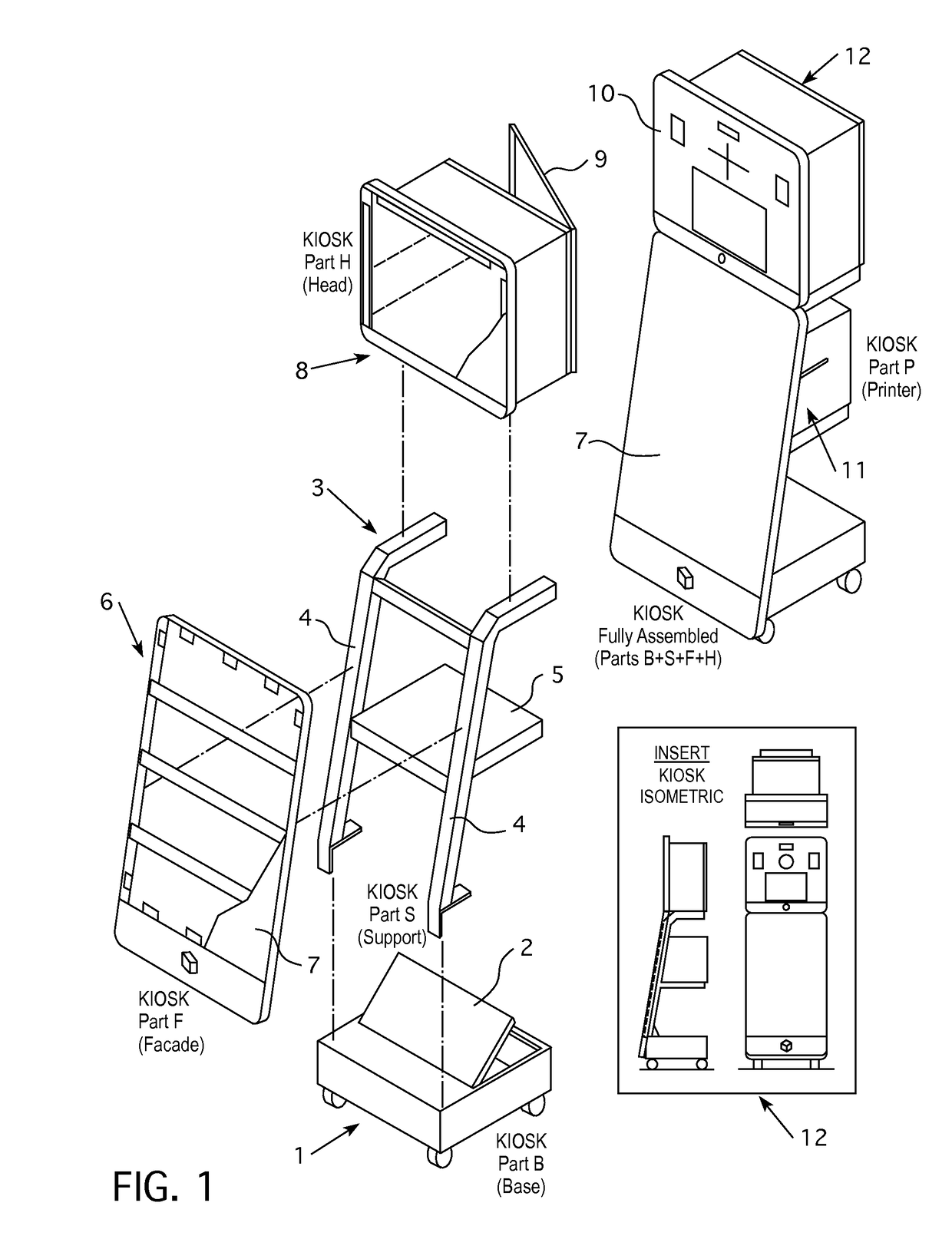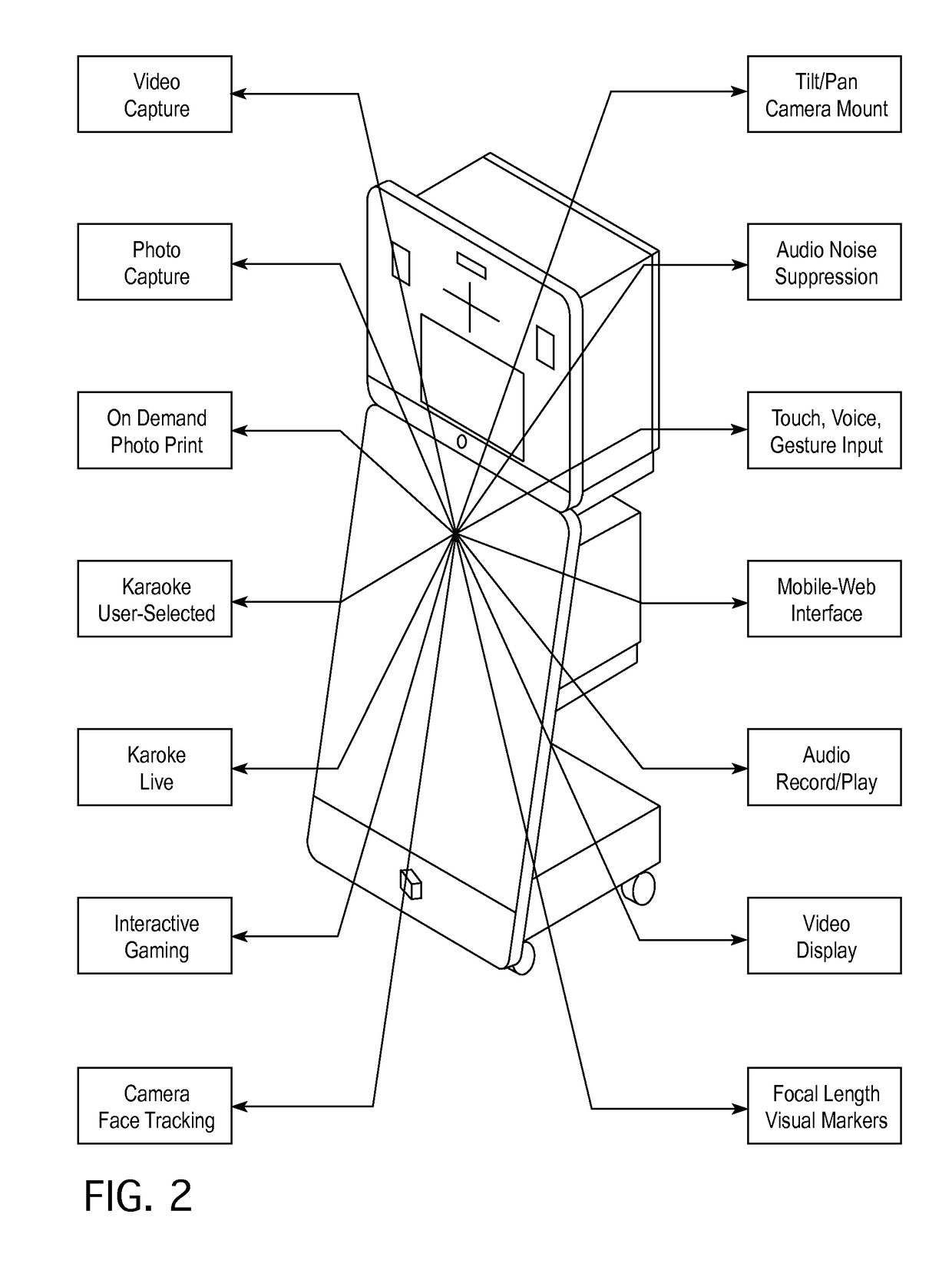[0005]The present invention relates to a mobile, multi-functioned kiosk and integrated production system for enhancing and recording a wide variety of events, including social events such as weddings, birthday parties, bar mitzvahs, and other types of events. The system and integral mobile device create an immersive photographic / videographic / entertainment experience that documents an event from several different and novel perspectives. The content produced and collected thereby can be transmitted to an internet based media platform to facilitate remote editing and centralized final assembly / issuance that can ultimately be transmitted to the end-user in various formats. In one embodiment, one or more devices (i.e., kiosks) are brought to the site of the event, in one or more small, easily transported pieces, and simply and rapidly assembled on site. Users are enabled to self-interact with the kiosk(s) through a simple user interface, via touch and / or verbal inputs, to concurrently record video content and produce digital and printed photographs on demand. The kiosk can adjust to record users of various heights in the center of the frame. The kiosk can be equipped with an audio noise cancelation means and voice processing systems to focus recording at the frequency of the human voice and depress / exclude extraneous background noise up to 115 db. The kiosk has one or more on-board cameras and one or more remote cameras which transmit content via an on-board wireless network, which is also connected to the internet. The kiosk(s) can play user-selected pre-recorded karaoke content or produce karaoke lyrics synchronized to prerecorded and / or live music, and capture the user(s) performance in both video and photos. The kiosks can be controlled by the user directly through an integral user interface or remotely by a third party via a mobile device and internet. The kiosk(s) are mobile and may be easily moved from location to location within the event site as a single unit by pushing the unit on rolling base, or they can be moved by means of a remotely controlled robotic base that transports the unit under its own power. The kiosk can be used in a form where it is tethered to the electrical grid, or it can be operated from its on-board self-contained power supply. In another embodiment, one or more kiosks are used at a wedding as entertainment and to capture festivities and guest messages, then the visual content and / or audio content is transmitted via the internet for production of a personal remembrance of the event.
[0015]Transporting the mobile kiosk to the event location in pieces of manageable size / weight, each of which can be easily handled by a person of average strength / size, has the advantage of not requiring specialized transport vehicles or dedicated delivery manpower services. An alternative style kiosk has the base, support and head connected to gether, for example by hinges, where a mechanical or pneumatic assist is provide to cause the collapsed components to open into a fully deployed structure, as described in greater detail hereafter. These alternatives allow the event facilitator, if so staffed, to load, transport, and unload the kiosk at the event using a compact vehicle. At the event location, the kiosk is rapidly and easily assembled as the pieces are keyed to fit together and locked in place by hand-tightened fasteners / set-screws or else a pneumatic actuator can cause the connected components to open using mechanical power. The kiosk requires only a source of electrical power, either from the venue electrical grid or from the kiosk on-board power supply. The kiosk and other system components become operational and ready to be used for their intended purposes through the kiosk user interface(s). The assembled, operational kiosk is compact and can require very little floor space (<2 ft2) and is mobile. In one embodiment the wheels / casters on the base allows it to be easily pushed / rolled throughout the venue. In another embodiment, it is outfitted with a robotic mobile base that allows the kiosk to move throughout the venue as directed by the event facilitator via a hand-held RF controller or in response to kiosk COMPUTER as commanded via the user interfaces(s).
[0016]The kiosk is fully automated, and controlled via user interface software. On user command, it records video and takes photographs. Video and photos can be stored as content for subsequent use in the post production of event videos and related services. Videos can also be viewed real-time with a display within the event via wired or local network connection, or remotely outside of the event via the internet. Through use of an optional printer, photographs can be printed on demand either as a photo-strip or larger format portrait as a favor for attendees. Likewise, photos can be viewed real-time with a display within the event, via wired or local network connection, or remotely outside of the event via the internet. Accompanying recorded audio tracks are processed to emphasize the frequency of human voice and are treated to minimize background noise, permitting the subject's voice to be clearly heard even in a loud sound field. The kiosk can play pre-recorded karaoke music and record subjects singing the lyrics. It can also identify and display karaoke lyrics in sync with prerecorded songs played at the venue by a DJ or songs performed live by a band at the event while concurrently recording subjects singing along to the song.
[0017]Event videos produced using the system described herein assembles a multiplicity of content, from a multiplicity of sources, to create a documentary of the event that is stylistically unique and more entertaining than the current best practice in this market / application. The uniqueness of the captured content is enhanced by the ease of use and relatively anonymous environment created by the kiosk, which permits users to lose ordinary inhibitions and display their creativity and innermost feelings. The process may begin by preparing the guests to be in attendance in advance by informing them (by various methods) of the use of the kiosk at the event, providing suggestions for different types of recordings (singing, offering advice, sharing memories, etc.), and soliciting participation to record content and / or take photos. This advance notice often leads to superior content by permitting the guest the time to prepare content. During the event, the event facilitator directs the proceedings and movement of all the various capture devices, and encourages all in attendance to utilize the kiosk to record content and photos. In addition to content generation by the kiosk and all photo / video cameras employed by the event team, a Photo / Video App for mobile devices is available to every participant at the event. The content from all of the individual smart phones / devices at the event can be uploaded to a common cloud-based site and combined with the photos / video recorded by the event attendees on their individual off-line devices (i.e., cameras). All of this content can be used and integrated into the final production of the event video to create a comparatively complete documentation of the event from virtually every possible perspective. The client is provided with the ability to view the content on-line, and annotate individual video clips and photos with names and other unique data, thereby personalizing the finished product and facilitating the retention key of identifiers and making the finished product more meaningful in the future.
 Login to View More
Login to View More 


